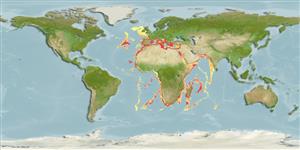Common names from other countries
Environment: milieu / climate zone / depth range / distribution range
Écologie
; profondeur 80 - 3300 m (Ref. 127635), usually 350 - 800 m (Ref. 80214). Tropical, preferred 19°C (Ref. 107945); 49°N - 30°S, 41°W - 75°E
Eastern Atlantic, Mediterranean and Western Indian Ocean: from Brazil to France, south to Natal, South Africa and east to Maldives.
Length at first maturity / Taille / Poids / Âge
Maturity: Lm 3.2 range ? - ? cm Max length : 22.0 cm TL mâle / non sexé; (Ref. 8); 7.1 cm CL (female); âge max. reporté: 6 années (Ref. 80242)
Demersal (Ref. 80214). Maximum length for females from Ref. 80234. Demersal on muddy bottoms of slopes of continental shelf, in zones close to submarine canyons. Moves from depths of 200 m during the night to 800 m during the day, and changes location within the year (Ref. 80214). Feeds on small benthic invertebrates mainly crustaceans and polychaetes and also carrion (Ref. 434).
Life cycle and mating behavior
Maturité | Reproduction | Frai | Œufs | Fécondité | Larves
Members of the order Decapoda are mostly gonochoric. Mating behavior: Precopulatory courtship ritual is common (through olfactory and tactile cues); usually indirect sperm transfer.
Holthuis, L.B. 1980. (Ref. 8)
Statut dans la liste rouge de l'IUCN (Ref. 130435)
statut CITES (Ref. 108899)
Not Evaluated
Not Evaluated
Utilisations par l'homme
Pêcheries: hautement commercial
FAO - pêcheries: landings, species profile | FIRMS (Stock assessments) | FishSource | Sea Around Us
Outils
Sources Internet
Estimates based on models
Preferred temperature
(Ref.
115969): 6.6 - 18.3, mean 13.3 (based on 351 cells).
Résilience
Haut, temps minimum de doublement de population inférieur à 15 mois (K=0.14-0.99; tmax=6).
Prior r = 0.66, 95% CL = 0.44 - 0.99, Based on 7 full stock assessments.
Vulnérabilité
Low vulnerability (12 of 100).
